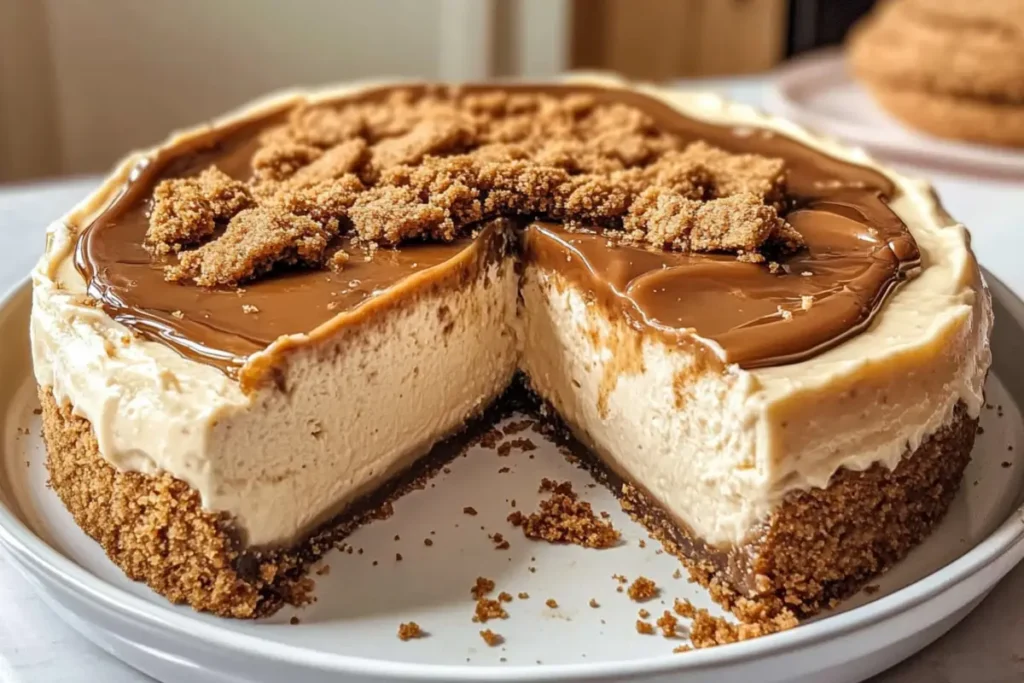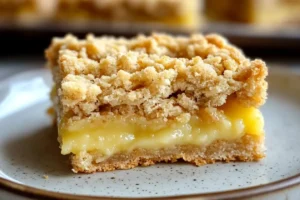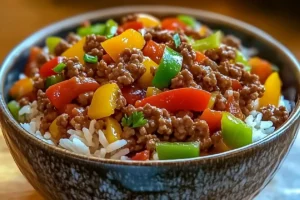Biscoff Cheesecake is the dessert that turns heads and wins hearts with every bite. From its rich cookie butter base to its silky smooth cream cheese filling, this no-bake treat is pure indulgence. Whether you’re planning a holiday table or just craving something sweet, Biscoff Cheesecake offers that perfect balance of spice, sweetness, and creamy goodness.
What sets Biscoff Cheesecake apart is its unique flavor profile—thanks to those caramelized spiced cookies we all know and love. It’s not just another cheesecake recipe. It’s a crave-worthy dessert that’s easy to make, requires no oven time, and delivers a melt-in-your-mouth experience. In this guide, we’ll cover everything from making the crust to chilling it right, plus answer your most asked questions.
Table of contents
- Bold Flavor Meets Creamy Texture in This Biscoff Cheesecake
- How to Make Biscoff Cheesecake from Scratch
- The Crust Dilemma – Biscoff vs Graham Crackers
- Biscoff Cheesecake Variations Worth Trying
- Common Mistakes When Making Biscoff Cheesecake
- How to Store and Serve Biscoff Cheesecake
- Nutritional Breakdown and Dietary Swaps
- FAQs About Biscoff Cheesecake
- More Great Recipes To Try
Bold Flavor Meets Creamy Texture in This Biscoff Cheesecake
What makes Biscoff cheesecake irresistible?
The flavor of Biscoff cheesecake is what instantly draws attention. It’s rich, buttery, and filled with warm notes of cinnamon and caramel that come straight from the Biscoff cookie base. These cookies are crushed to create the crust, while Biscoff spread—also known as cookie butter—gets blended into the creamy filling. The result? A cheesecake that tastes like your favorite spiced cookie, only creamier.
Unlike traditional cheesecakes that rely on vanilla or fruit to deliver flavor, Biscoff cheesecake stands out with a distinct spiced sweetness. This isn’t a dessert that blends into the background. The moment it hits the table, its caramel color and bold aroma make a strong impression. And when you take a bite, it melts into a smooth, spiced cream that’s anything but ordinary.
This dessert also shines because of its texture. The contrast between the slightly crunchy crust and the smooth, mousse-like filling makes every bite layered and satisfying. With just a few ingredients, it delivers restaurant-level flavor—no oven required.
The role of cookie butter and Biscoff spread in flavor depth
Biscoff spread is the soul of the cheesecake. Made by grinding Biscoff cookies into a smooth paste, this cookie butter acts as both a flavoring and a binder in the filling. Its naturally spiced profile intensifies the taste of the cheesecake and gives it that signature warmth.
When you add Biscoff spread to the cream cheese and whipped cream base, it thickens the mixture slightly while boosting flavor. The result is a no-bake filling that’s not just creamy but also deeply satisfying. It doesn’t need vanilla extract, citrus zest, or any other flavor enhancers. The cookie butter does all the heavy lifting.
Many recipes also add a drizzle of melted Biscoff spread on top or swirl it through the batter before chilling. These simple touches give the cheesecake that bakery-style look while doubling down on the flavor. In short, Biscoff spread transforms a basic no-bake dessert into a bold, craveable centerpiece.
Indulge in a delightful and easy-to-make dessert with this Strawberry Cheesecake Dump Cake.
How to Make Biscoff Cheesecake from Scratch
Ingredients needed for authentic Biscoff cheesecake
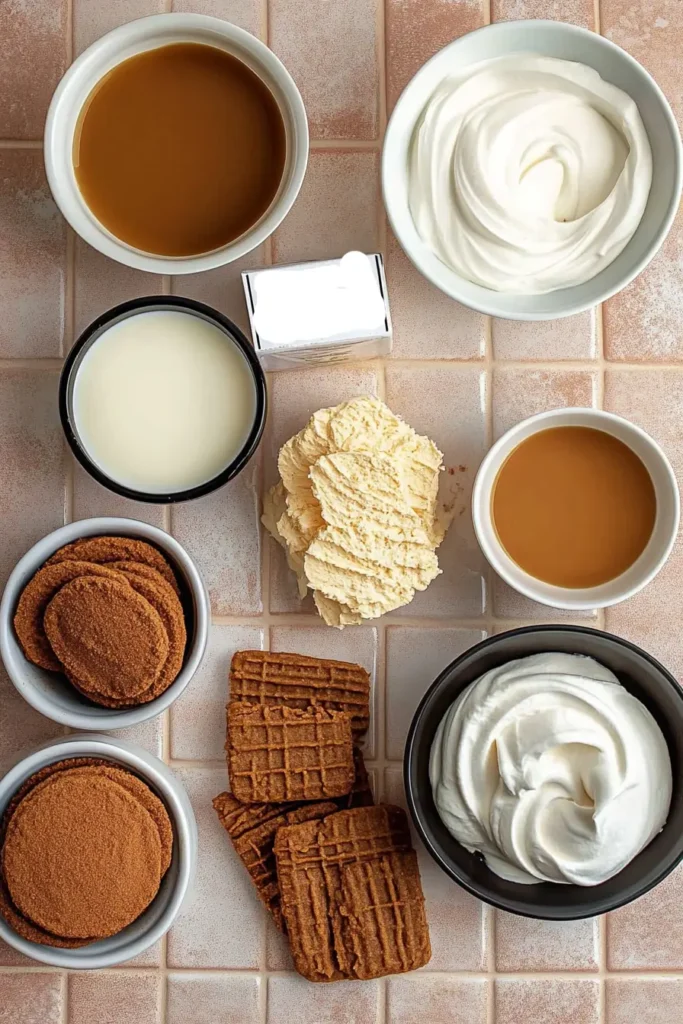
Making Biscoff cheesecake from scratch requires just a few easy-to-find ingredients, most of which are pantry staples. Here’s what you’ll need:
- Biscoff cookies – These form the crust. You’ll need about 2 cups crushed.
- Melted butter – Helps bind the crust together and adds richness.
- Cream cheese – The main base for the filling. Use full-fat blocks for best texture.
- Powdered sugar – Sweetens the filling without making it grainy.
- Vanilla extract – Optional, but it can round out the flavor.
- Heavy cream or whipping cream – Adds lightness and volume when whipped.
- Biscoff spread (cookie butter) – The key ingredient for that deep spiced flavor.
Here’s a quick look at the base ingredient ratios:
| Ingredient | Amount |
|---|---|
| Biscoff Cookies | 200g (about 26 cookies) |
| Melted Butter | 5 tbsp |
| Cream Cheese | 16 oz (2 blocks) |
| Powdered Sugar | ¾ cup |
| Biscoff Spread | ½ cup |
| Heavy Cream | 1 cup (whipped to stiff peaks) |
Step-by-step method for no-bake preparation
Start by preparing your crust. Crush the Biscoff cookies using a food processor or rolling pin until they’re fine crumbs. Combine with melted butter and press into the bottom of a springform pan. Use the back of a spoon or flat-bottomed glass to pack it down tightly. Chill the crust while you work on the filling.
In a large bowl, beat the cream cheese until smooth. Add powdered sugar and beat again until fully combined. Mix in the Biscoff spread until it’s evenly incorporated and creamy. In a separate bowl, whip the heavy cream until stiff peaks form. Gently fold the whipped cream into the Biscoff mixture. Take your time to keep the texture airy.
Spoon the filling onto the chilled crust and smooth the top with a spatula. Cover the cheesecake and refrigerate for at least 6 hours—overnight works best for a firm, sliceable texture. Once set, add optional toppings like crushed Biscoff cookies or a drizzle of melted cookie butter.
And that’s it. No oven, no water bath, and no stress—just a smooth, rich dessert that delivers every time.
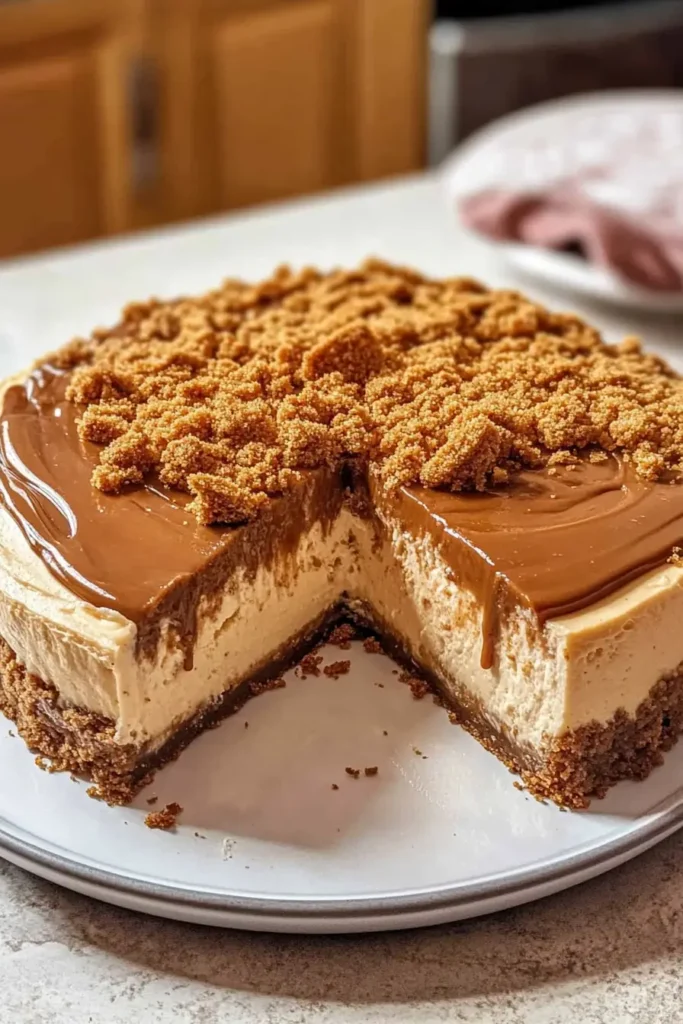
The Crust Dilemma – Biscoff vs Graham Crackers
Can you use Biscoff cookies instead of graham crackers?
Yes, you absolutely can—and should—use Biscoff cookies instead of graham crackers when making cheesecake. Biscoff cookies offer a deeper, more aromatic flavor that goes beyond the mild sweetness of graham crackers. They’re spiced with cinnamon and caramel notes, which makes them ideal for creating a more flavorful and memorable crust.
When crushed, Biscoff cookies have a slightly finer texture than graham crackers. This helps the crust bind better when combined with melted butter. It also results in a crisper bite after chilling, which holds up beautifully against the creamy filling of the cheesecake.
If you’ve been using graham crackers by default, switching to Biscoff is a game changer. Not only does it amplify the flavor, but it also complements the Biscoff spread in the filling. The flavor stays consistent from the base to the topping, giving your cheesecake a more unified taste.
Flavor differences between traditional crusts and Biscoff-based crust
Graham cracker crusts are neutral and slightly sweet, acting more as a structural base than a flavor highlight. They do the job well but rarely stand out. Biscoff crusts, on the other hand, are bold. The spiced, caramelized notes from the cookies add a whole new layer of richness.
Here’s a quick flavor comparison:
| Crust Type | Flavor Profile | Best Uses |
|---|---|---|
| Graham Cracker | Mild, slightly sweet, toasty | Traditional cheesecakes, key lime pie |
| Biscoff Cookie | Spiced, caramelized, rich | No-bake cheesecakes, spiced desserts |
Choosing Biscoff for your crust not only adds flavor but also improves the overall harmony of your cheesecake. If you’re already using Biscoff spread in the filling, this creates a full-circle dessert where every bite is bursting with warmth and depth.
Indulge in a delightful fusion of flavors with this Matcha White Chocolate Mochi Cake.
Biscoff Cheesecake Variations Worth Trying
Mini Biscoff cheesecakes for individual servings
Mini Biscoff cheesecakes are a fun, mess-free version of the full-sized classic. They’re great for parties, gifts, or anytime you want controlled portions. All you need are cupcake liners and a muffin tin. Press a small amount of crushed Biscoff cookies mixed with butter into each liner, then spoon in your creamy filling. Chill them just like you would the regular cheesecake.
These mini versions set faster—usually within 4 to 5 hours—and they’re easy to serve without slicing. You can top each with a swirl of Biscoff spread, a dollop of whipped cream, or half a cookie for extra crunch. The flavor remains bold and creamy, just in a more portable package.
They’re also great for dessert platters or holiday trays. Because they don’t require cutting, there’s less cleanup, and every guest gets a perfect bite. Plus, the presentation is always a hit.
Biscoff swirl cheesecake with added flavor dimensions
Want something more eye-catching? Try making a Biscoff swirl cheesecake. This technique adds visual flair and concentrated pockets of Biscoff flavor right in the filling. After pouring the cheesecake mixture into the crust, dollop spoonfuls of slightly warmed Biscoff spread over the top. Then, use a skewer or knife to swirl the spread into the filling.
The result is stunning. You get beautiful ribbons of cookie butter throughout the cake, giving it a marbled look and a burst of extra flavor with every forkful. It takes just a couple extra minutes but makes your cheesecake feel bakery-made.
This variation is especially impressive when you’re serving guests or posting your dessert online. It’s also flexible—you can add more or less swirl depending on how bold you want the cookie butter taste to be.
Common Mistakes When Making Biscoff Cheesecake
Why your crust might fall apart and how to fix it
A common issue when making Biscoff cheesecake is a crust that crumbles or falls apart when slicing. This usually happens because there’s either not enough butter to bind the crumbs, or the crust wasn’t pressed firmly enough into the pan. Unlike graham crackers, Biscoff cookies are a bit drier, so they need a little extra fat to hold together.
To fix this, always measure your cookie crumbs and butter accurately. Aim for about 5 tablespoons of melted butter per 200g of Biscoff crumbs. When pressing the crust into the pan, use the bottom of a measuring cup or glass to pack it down tightly and evenly. Then chill it for at least 20–30 minutes before adding the filling. This step helps the crust set and gives it a firm texture once the cheesecake is fully chilled.
If your crust still seems too loose, you can mix in 1 tablespoon of brown sugar. It helps bind the crumbs and gives a slight caramel note that pairs well with the cookie flavor.
Overmixing or under-chilling: texture killers to avoid
Overmixing the filling is another mistake that can ruin your cheesecake’s smooth, airy texture. If you beat the mixture too long after adding the whipped cream, you’ll deflate the air and end up with a dense, flat filling. Fold gently instead of using a mixer during the final step. This keeps the filling light and mousse-like.
Under-chilling is just as problematic. No-bake Biscoff cheesecake relies on time in the fridge to fully set. Rushing this step can lead to runny slices or filling that oozes out when cut. Always chill for at least 6 hours, but overnight is ideal.
If you need to speed things up, place the cheesecake in the coldest part of your fridge and avoid opening the door too often. Freezing it briefly is also possible, but don’t overdo it—frozen cheesecake can crack and lose its creamy texture.
How to Store and Serve Biscoff Cheesecake
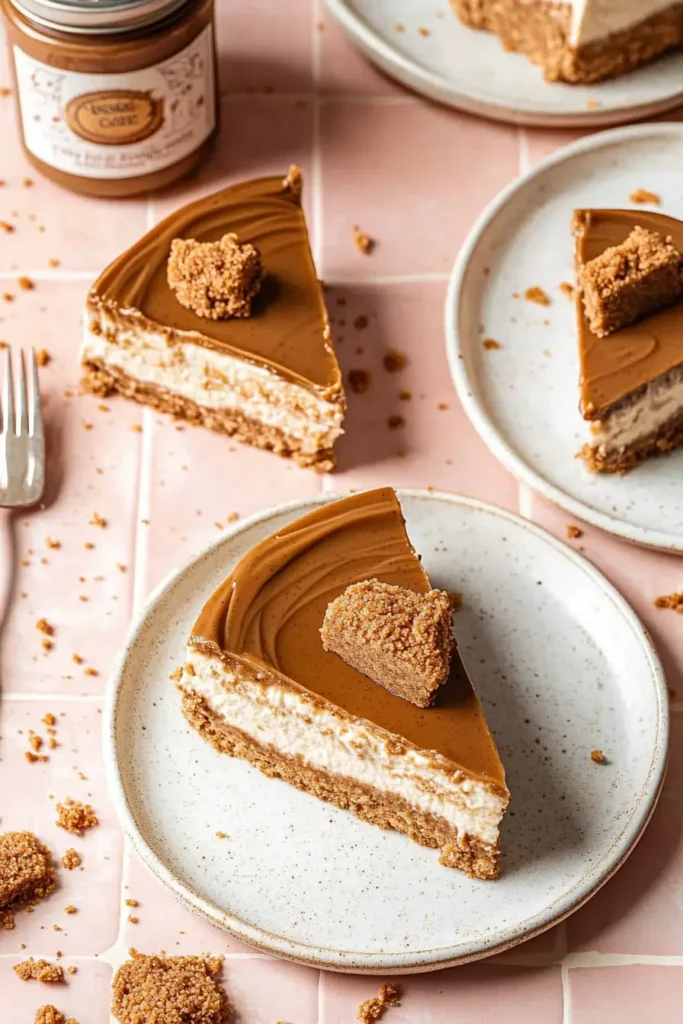
Refrigeration and freezing tips
Storing Biscoff cheesecake the right way keeps it fresh, creamy, and ready for whenever your sweet tooth strikes. For short-term storage, keep the cheesecake covered in the refrigerator. It will stay fresh for up to 5 days. Use plastic wrap or an airtight container to prevent it from drying out or picking up fridge smells.
If you want to make it ahead of time or save leftovers, freezing is also an option. To freeze, chill the cheesecake fully first. Then wrap it tightly in plastic wrap and again in aluminum foil. You can also freeze individual slices for easier portioning later. When you’re ready to enjoy it, let it thaw in the fridge overnight.
Avoid thawing at room temperature, as that can cause the filling to weep or become too soft. Proper storage means your Biscoff cheesecake stays delicious for days—or even weeks in the freezer.
Serving ideas to impress guests or indulge solo
Biscoff cheesecake is already a showstopper, but how you serve it can take it up a notch. For a classic presentation, top it with a drizzle of warmed Biscoff spread and a sprinkle of crushed Biscoff cookies. You can also add whipped cream swirls or even a full Biscoff cookie on each slice.
For a more indulgent twist, try topping with caramel sauce, chocolate ganache, or a pinch of sea salt. These flavors play well with the warm spices in the cheesecake and give it that extra edge.
Serving to guests? Use a hot knife to slice it cleanly and place each piece on chilled dessert plates. Add a small mint sprig or a dusting of cinnamon for a polished look.
Even if you’re just treating yourself, take the time to plate it nicely—you deserve it. A well-served cheesecake is more than dessert. It’s a moment.
Nutritional Breakdown and Dietary Swaps
Typical nutrition profile of a slice
Biscoff cheesecake is rich, satisfying, and worth every bite—but it’s also on the indulgent side. A standard slice (based on an 8-slice recipe) delivers about:
| Nutrient | Approximate Value per Slice |
|---|---|
| Calories | 450–500 kcal |
| Fat | 35g |
| Saturated Fat | 20g |
| Sugar | 18–22g |
| Protein | 6g |
This cheesecake is definitely a treat, but the good news is that it’s rich enough to satisfy in small portions. Even a half-slice can hit the spot when you just want a little sweetness.
Vegan, gluten-free, and lighter ingredient substitutions
If you’re following a specific diet, there are smart ways to enjoy Biscoff cheesecake with a few tweaks.
- Vegan swaps: Use dairy-free cream cheese, coconut cream (instead of heavy cream), and a vegan Biscoff alternative (many Biscoff spreads are already dairy-free, but check the label). For the crust, choose plant-based butter.
- Gluten-free version: Biscoff cookies contain wheat, but you can substitute with gluten-free speculoos-style cookies or gluten-free graham crackers with a little extra cinnamon.
- Lighter version: Use reduced-fat cream cheese, swap heavy cream for Greek yogurt, and use less sugar or a sugar substitute like monk fruit or erythritol. The texture will be slightly different but still creamy and enjoyable.
With these changes, you can still enjoy the spiced, sweet flavor of Biscoff cheesecake while adjusting for dietary needs or preferences.
Indulge in the delicate and fragrant flavors of this Rose Milk Cake, a fusion dessert that combines the richness of tres leches cake with the floral sweetness of rose milk.
FAQs About Biscoff Cheesecake
What is Biscoff cheesecake made of?
Biscoff cheesecake is made with crushed Biscoff cookies and melted butter for the crust, and a creamy filling that includes cream cheese, powdered sugar, whipped cream, and Biscoff spread (cookie butter). It’s typically a no-bake dessert, making it simple yet decadent.
What is the flavor of Biscoff?
Biscoff has a warm, spiced flavor with notes of cinnamon, brown sugar, and caramel. It tastes similar to a spiced shortbread or speculoos cookie. When used in cheesecake, it gives the dessert a cozy, sweet, and slightly nutty flavor profile.
Can you use Biscoff instead of Graham crackers?
Yes, Biscoff cookies are an excellent substitute for graham crackers in cheesecake crusts. They provide a more flavorful, aromatic base with a spiced caramel taste that pairs perfectly with cream cheese fillings.
Can I make cheesecake with Biscoff biscuits?
Absolutely. Biscoff biscuits (cookies) can be crushed and used as the crust, and the Biscoff spread can be blended into the filling for bold, rich flavor. Together, they create a cohesive dessert that’s both unique and crowd-pleasing.
Biscoff cheesecake is more than just a trendy dessert—it’s a flavor-packed, no-bake indulgence that’s easy to make and even easier to enjoy. With its spiced cookie crust, smooth cream cheese filling, and rich cookie butter swirls, every bite offers comfort and satisfaction. Whether you go for the classic version, minis, or a swirled top, this cheesecake brings warmth and wow-factor to any occasion.
More Great Recipes To Try
- Gluten Free Chocolate Cake Recipe – Decadent, Moist & So Simple
- Strawberry Cheesecake Dump Cake – Easy, Creamy & Irresistible
- Rose Milk Cake Recipe – A Fragrant & Irresistible Dessert to Try!
- Madeline Cookies Recipe Using Cream – Moist & Elegant Treat
- Delicious Matcha Crepe Roll Cake – The Ultimate Light
Don’t miss out on amazing recipes! Follow butteryrecipes on Pinterest and Facebook today!
Print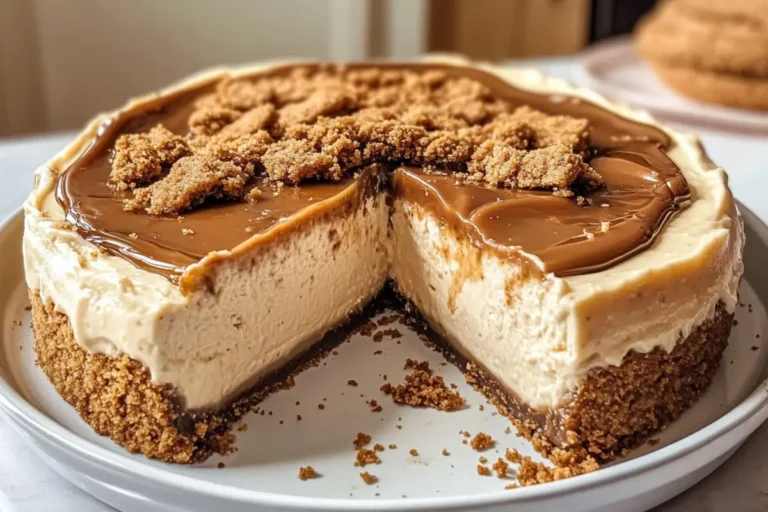
Biscoff Cheesecake Secrets: Irresistible Recipe You’ll Love
This no-bake Biscoff Cheesecake is creamy, indulgent, and bursting with the warm spiced flavor of cookie butter. Perfect for holidays or whenever you need a slice of sweet comfort.
- Total Time: 6 hours 20 minutes
- Yield: 8 servings 1x
Ingredients
- 200g Biscoff cookies (about 26 cookies)
- 5 tbsp melted butter
- 16 oz (2 blocks) cream cheese, full-fat
- ¾ cup powdered sugar
- ½ cup Biscoff spread (cookie butter)
- 1 cup heavy cream, whipped to stiff peaks
- Optional: 1 tsp vanilla extract
Instructions
- Crush Biscoff cookies into fine crumbs using a food processor or rolling pin.
- Mix crumbs with melted butter and press into the bottom of a springform pan. Chill while preparing filling.
- Beat cream cheese until smooth. Add powdered sugar and beat until combined.
- Mix in Biscoff spread until evenly blended.
- Whip heavy cream to stiff peaks and gently fold into Biscoff mixture to keep it airy.
- Spoon filling over chilled crust and smooth the top. Cover and refrigerate at least 6 hours or overnight.
- Optional: top with crushed Biscoff cookies or drizzle of melted cookie butter before serving.
Notes
Chilling overnight yields the best texture. Be sure not to overmix after adding whipped cream. For a swirl effect, dollop and swirl extra Biscoff spread into the top before chilling.
- Prep Time: 20 minutes
- Cook Time: 0 minutes
- Category: Dessert
- Method: No-Bake
- Cuisine: American
Nutrition
- Serving Size: 1 slice
- Calories: 480
- Sugar: 20g
- Sodium: 250mg
- Fat: 35g
- Saturated Fat: 20g
- Unsaturated Fat: 12g
- Trans Fat: 0g
- Carbohydrates: 32g
- Fiber: 1g
- Protein: 6g
- Cholesterol: 90mg
Keywords: biscoff cheesecake, no-bake dessert, cookie butter cheesecake
